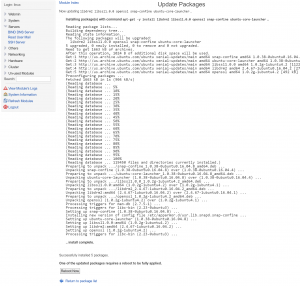Merry Christmas 2015!
Merry Christmas everyone! Have a wonderful Christmas and Happy New Year!
“8 That night there were shepherds staying in the fields nearby, guarding their flocks of sheep. 9 Suddenly, an angel of the Lord appeared among them, and the radiance of the Lord’s glory surrounded them. They were terrified, 10 but the angel reassured them. “Don’t be afraid!” he said. “I bring you good news that will bring great joy to all people. 11 The Savior—yes, the Messiah, the Lord—has been born today in Bethlehem, the city of David! 12 And you will recognize him by this sign: You will find a baby wrapped snugly in strips of cloth, lying in a manger.” – Luke 2:8-12 NLT
Posted in Holiday
Windows Misinformation in Action
In this blog post, I will be responding to an online comment made by a user that gives misinformation about Windows. The comment can be located at: https://discuss.howtogeek.com/t/htg-explains-why-does-windows-want-to-reboot-so-often/13393/5 Please note that I mean *no* disrespect to the author of the comment in any way.
The direct quotes (quotes were copied and pasted directly from the website itself; I made no changes to the quotes) from the article are in red, and my responses are in black.
Simple really, Windows is inherently flawed by both a poor design
Windows is not “inherently flawed” by poor design. For example, in Windows (since Windows 7, I believe) if your display driver crashes for whatever reason, instead of blue screening, Windows just restarts the display driver and you are all set! This is a great design in Windows’ driver model.
Another example of good design is that Windows supports many different security features like: Access Control Lists, Mandatory Access Control, Disable Memory Execution, Address Space Layout Randomization, integrated firewall (Windows Firewall), etc.
Not to mention Windows NT was designed from the beginning to be a multi-user, networking capable operating system, for small and large businesses alike to use. This was before the consumer NT versions came out onto the market (like Windows XP).
Windows (NT versions) are far from “inherently flawed”. That is just spreading fear, uncertainty, and doubt to less technical computer users.
and a legion userbase who is mor ethan willing to accept any remotely plausible answer concerning why presumably simple things are so obtuse in the windows world.
You are pretty much calling Windows users idiots. With all due respect, this is not a technical argument. You are just throwing a “low punch” at people who have a different opinion than yourself.
You say “simple things are so obtuse in the windows world”, but you didn’t give any technical arguments!
Bottom line the reason reboots are necessary is the security model (or lack thereof) of windows. Simply up until windows 7 and 8 (supposedly anyway) windows had a boiler plate security model.
Nope! Not true at all. Windows requires a reboot after updates to make sure that all the updated files that are used by the system and user-installed programs are using the newly updated files.
Let me explain. When you load a program, all of the required / critical files associated with that program get loaded into memory (e.g., DLL files). Now when you update certain files that are being used by other programs, you have updated those files, but the computer memory still retains the older version of those files you updated. The programs will not re-cache the newer files into memory, until the programs have been restarted.
Microsoft just opted to force the user to reboot, so security, stability, and performance updates are actually applied, and not just lying dormant until the user happens to reboot the computer. Of course, any program that is not currently running, or a program that you manually restart, will then use the updated files automatically.
In addition, Linux has the same problem. Users who update important libraries and whatnot need to restart their services on their Linux boxes to have the newly updated files take effect. The problem? There is no real guarantee for Linux users that just by restarting their system services that all of the system programs are using the newly updated files. It would be a good idea for Linux users to reboot their systems just like Windows users do, to make sure that all of the running programs are making use of the important updated files. This website recommends that Linux users reboot their systems after installing important updates.
The picture below will show you Webmin telling me that Ubuntu Linux needs a reboot after doing some updates. Basically this disproves anyone who claims that Linux does not need a reboot after doing updates.
While the file system provides file level security, and the os does as well, the applications and developers of windows applications do not follow best practices and many applications require administrative access to install and use.
This has nothing to do with Windows. This is a fault of certain application developers. This is not an OS specific issue either. Any OS can have bad programmers writing software.
How this translates to rebooting is that the updates can not guarantee at any given time the context they (update software) is operating in, as the line beween administrator and users is somewhat vague. (this is why windows is so virus and malware porus)
I am not sure what you are trying to say.
Linux does have malware. It is rare to actually get malware on Linux, but the same goes for a properly setup Windows computer with a user that uses common sense. Just because someone uses Windows does not mean that they will catch malware, nor is Windows typically easy to infect.
I would say 99% of all Windows infections nowadays are caused by the user allowing the malware to infect the system (e.g., running an infected program as Administrator, opening an e-mail attachment manually from an unknown e-mail, running random downloaded exe files from the Internet), not the malware just “getting in” by itself without accidental help from the user.
Windows NT was supposed to allow updates without reboots. In fact OS/2 did that as well, and as a precursor to NT, the only remainin greason for a reboot is laziness on the part of developers and failure to motivate application developers to provide mechanisms to install theiur software without admin privileges.
As this link will show you, Windows rebooting for updates is not a “lazy developer” problem. It is a good design decision based upon logical reasoning.
———-
Almost everyone (not all, of course 🙂 ) that I have encountered, that happens to prefer an OS other than Windows (or at least comes across as if they hate Windows), seems to think that it is their “calling” to trash Windows with little to no technical arguments.
Then when you do give technical arguments to these people, in my experience they will just argue and mock you to the point that you really do not know why you even bothered to respond to their misinformation.
I had one guy literally copy and paste my whole response (that I made on another website), and replaced some of my words to make it sound like I was saying the opposite of what I really said! No polite, honest, mature conversation. No technical arguments. I just got mockery. He probably didn’t have any responses to begin with, and needed to mock me since he did not have anything else to give in response!
Linux is a good operating system for servers, but let’s not get carried away with thinking that it is the _only_ OS out there worth its salt. There are other ones like FreeBSD, OS X, and of course Windows that have their own share of pros. I have used both Windows and Linux, and I can see the good and bad in both OSes.
Posted in Computers, Operating Systems

